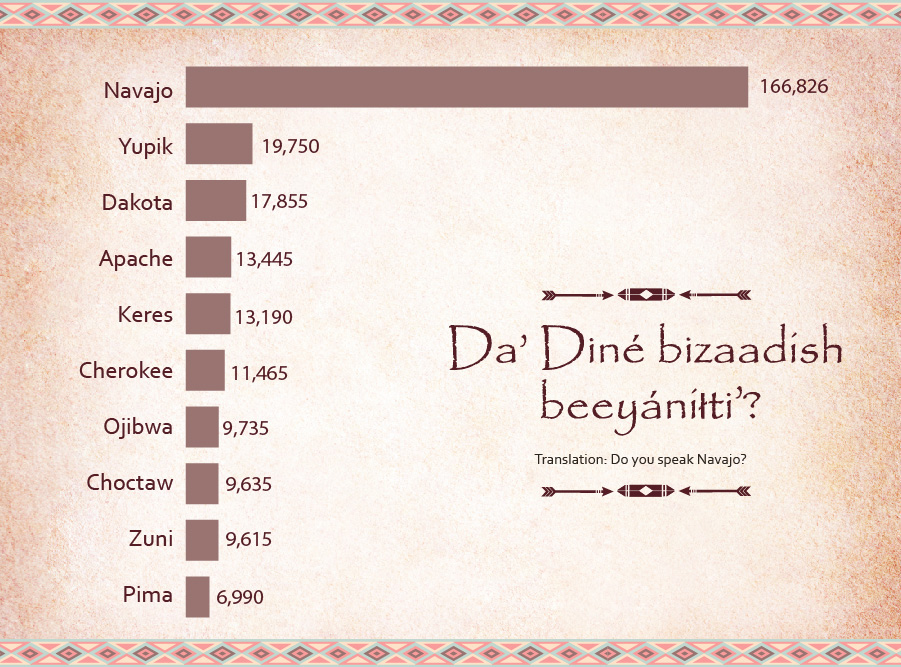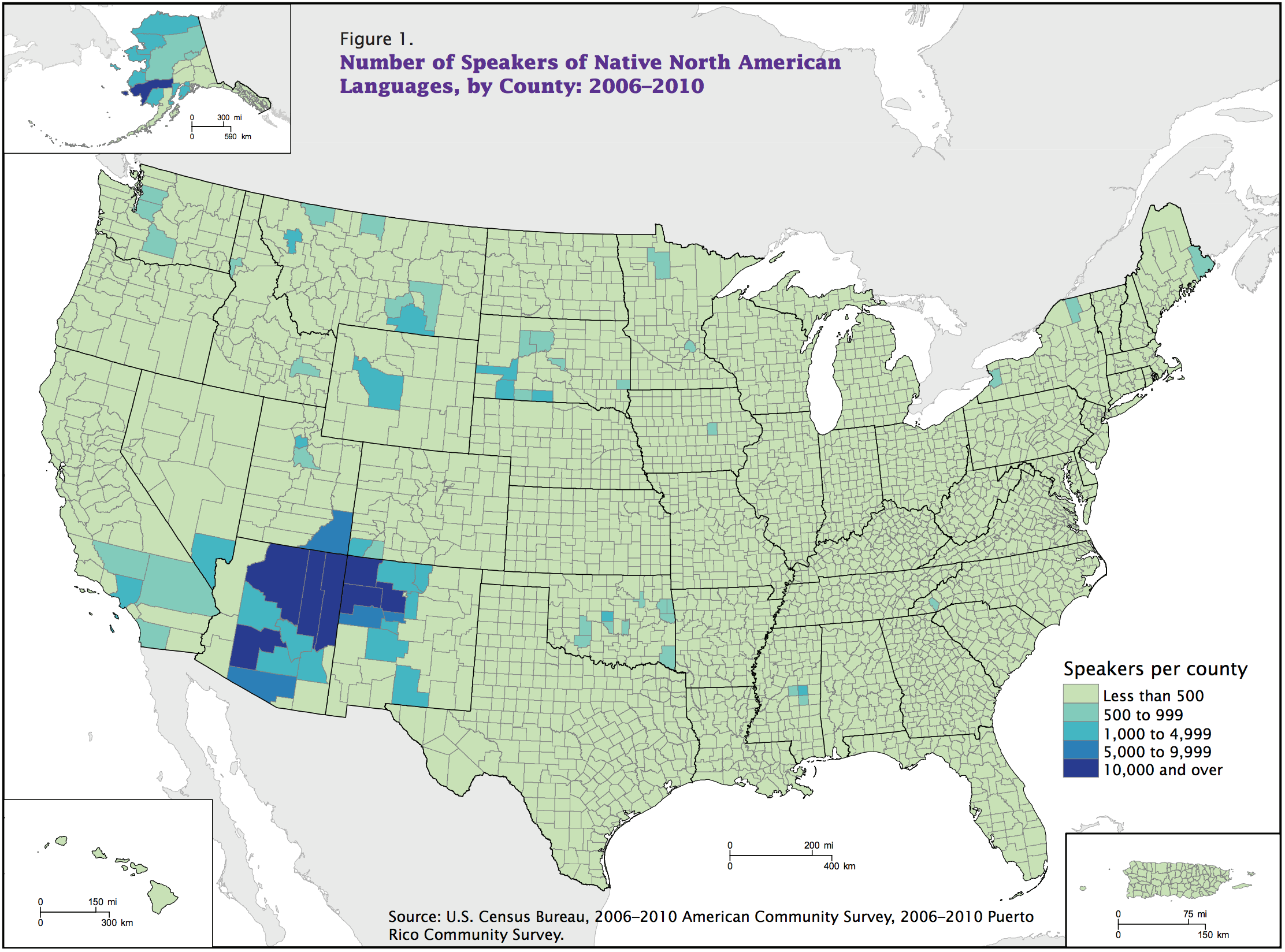Lesson 24
Assess the Reasonableness of Solutions
Warm-up: Notice and Wonder: Native American Languages (10 minutes)
Narrative
Launch
- Display the image.
- Explain that the names are Native American languages.
Activity
- “What do you notice? What do you wonder?”
- 1 minute: quiet think time
- Share and record responses.
Student Facing
What do you notice and what do you wonder?

Student Response
For access, consult one of our IM Certified Partners.
Activity Synthesis
- Reveal that the infographic shows the top ten most widely spoken Native American languages in the United States, collected in 2009–2013. The numbers represent people over 5 who speak the language.
- Consider sharing that about 170 Native American languages are spoken in the U.S., but many are on the verge of disappearing.
- “Based on what you see here, could you predict how many people speak the 20th most widely spoken language? The language in the 100th place?”
- Consider showing a census map showing the distribution of Native American languages. Here is one from a survey done by the U.S. Census in 2006–2010:

Activity 1: Do You Speak Navajo? (20 minutes)
Narrative
The purpose of this activity is for students to practice using estimation and using the standard algorithm for addition and subtraction to solve problems involving large numbers. The same data from the warm-up is used as a context. The last two questions prompt students to first examine the data set and make some estimations before deciding which pairs of numbers to use to find the answers.
Students reason abstractly and quantitatively with several operations in order to estimate and solve the problems (MP2).
Advances: Listening, Speaking
Supports accessibility for: Language, Memory
Required Materials
Materials to Gather
Launch
- Groups of 2
- Give students access to grid paper.
- “What languages are spoken in your family or your neighborhood?“
- “Do you or your friends use different languages in different places or occasions?“
- “For this activity, you'll need to refer to the data you saw in the warm-up.“
Activity
- 7–8 minutes: quiet work time
- 3–5 minutes: partner discussion
- Monitor for students who:
- use the bar graphs from the warm-up to help them estimate question 1b
- use estimation or rounding to assess whether their response is reasonable
- group some numbers selectively to make estimation or computation more efficient
Student Facing
-
In the list of the ten most widely spoken Native American languages in the U.S., Navajo and Yupik are the most widely spoken.
-
How many more Navajo speakers are there than Yupik speakers? Show your reasoning.
language number of speakers Navajo 166,826 Yupik 19,750 Dakota 17,855 Apache 13,445 Keres 13,190 Cherokee 11,465 Ojibwa 9,735 Choctaw 9,635 Zuni 9,615 Pima 6,990 - About how many times as many Navajo speakers as there are Yupik speakers? Show your reasoning.
-
-
Navajo, Apache, and Cherokee languages have been used during wartime to help the U.S. military keep its communications secure and incomprehensible to their enemies.
- Based on the data here, how many people might have been able to understand the communications? Show your reasoning.
- How do you know that your answer is reasonable?
- Are there more Navajo speakers than the speakers of all the other nine languages combined? Explain or show how you know.
Student Response
For access, consult one of our IM Certified Partners.
Activity Synthesis
- Invite students to share their responses and reasoning.
- “How did you know what operations to use to answer the first set of problems? The second problem? The last problem?”
- “How do you know that your answer is reasonable?” (Mentally use a standard algorithm to find the differences, round the numbers, or look only at certain digits to estimate.)
Activity 2: Languages in Philadelphia and Chicago (15 minutes)
Narrative
In this activity, students continue to analyze population data and to use addition and subtraction skills to solve problems. The first question, which prompts students to compare two population groups, could be answered by rounding and estimating rather than precise calculations. Students who look for structure may notice that the number of digits in each row in the table changes by one digit as we move down the table. They make use of this observation to simplify their estimation or calculation (MP7).
Note that the data shown here do not represent all language types spoken in the two major cities. If desired, consider finding local data or data that reflect the languages spoken in your students' community. Then, ask students to make comparisons as shown in the activity.
Launch
- Display the two sets of data.
- “What do you notice? What do you wonder?”
- 1 minute: quiet think time
- Share and record responses.
Activity
- 5 minutes: independent work time
- Monitor for:
- the different strategies students use to answer the first question
- the different ways in which students decide to add numbers (for example, the largest numbers first, or three numbers at a time)
Student Facing
Philadelphia, the birthplace of the United States, is a diverse city and home to people of different backgrounds.
The table shows 2017 data on some types of languages spoken in Philadelphia and the numbers of people who speak them.
| language | number of speakers in Philadelphia |
|---|---|
| English only | 1,224,539 |
| Spanish | 127,352 |
| Other Indo-European | 6,750 |
| Asian | 364 |
- Based on the data, are there more people in Philadelphia who only speak English or more people who speak a language other than English? Show how you know.
- What is the difference between the number of people who speak only English and those who speak another language? Show how you know.
-
Chicago is a city with a similar population to Philadelphia.
This table shows data on some types of languages spoken by people in Chicago.
language number of speakers in Chicago English only 1,731,836 Spanish 422,568 Other Indo-European 25,777 Asian 1,005 - How many more speakers of Spanish and other Indo-European languages are in Chicago than in Philadelphia? Show your reasoning.
- How do you know your answer is reasonable?
Student Response
For access, consult one of our IM Certified Partners.
Activity Synthesis
- Select students to share their responses and reasoning.
- If no students answered the first question by estimation, ask if it could be done and how.
- Discuss potential pros and cons of rounding. (Pro: It would be quicker. Con: The data for each group of languages have a different number of digits, so it’s hard to choose the place to which the numbers should be rounded. If we round to different places for each group, we’d end up over- or under-estimating some groups much more than others.)
Lesson Synthesis
Lesson Synthesis
“Today we performed addition and subtraction on very large numbers. Even though most of us used the standard algorithm, we didn’t all add or subtract the numbers the same way.”
“In the second activity, you had to add a series of numbers in a table. Which numbers did you add (or subtract) first? Does it matter?”
“When the numbers being added or subtracted have many digits, it is easy to make an error, to regroup or carry incorrectly, or to get the digits mixed up. What are some ways we could check our answers? What are some common errors, and how can we avoid them?”
Cool-down: The Children and the Elderly (5 minutes)
Cool-Down
For access, consult one of our IM Certified Partners.
Student Section Summary
Student Facing
In this section, we encountered problems that involve large numbers from different contexts and that could be solved with different strategies.
In the beginning, we saw at least five ways to find the product of 45 and 18: by multiplying and dividing in parts, using a series of equations, drawing diagrams, and more.
Later, we explored problems about measurements, with numbers up to four digits. We found that, often, the same problem could be solved using different operations.
For example, in the fitness challenge activity, Han took 32,550 steps in 7 days. We can find the number of steps he took each day by thinking in terms of multiplication (what number times 7 is 32,550?) or in terms of division (what is 32,550 divided by 7?).
We can also write different equations.
\(7 \times n = 32,\!550\)
\(32,\!550 \div 7 = n\)
To find out how many steps Han had to take to reach a goal of 120,000 steps if he had 96,897 steps, we can think in terms of addition (what number must be added to 96,897 to make 120,000?) or subtraction (what is the difference between 120,000 and 96,897?).
\(96,\!897 + n = 120,\!000\)
\(120,\!000 - 96,\!897 = n\)